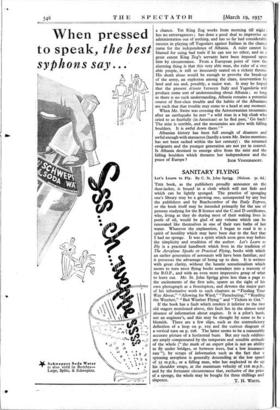SANITARY FLYING
Let's Learn to Fly. By C. St. John Sprigg. (Nelson. 3s. 6d.) Tins book, as the publishers proudly announce on the dust-jacket, is bound in a cloth which will not fade and which can be lightly sponged. The practice of sponging one's library may be a growing one, unsuspected by any but the publishers and by Beachcomber of the Daily Express, or the book itself may be intended primarily for the use of persons studying for the B licence and the C and D certificates, who, living as they do during most of their waking lives in pools of oil, would be glad of any volume which can be renovated like themselves in one of their rare baths of hot water. Whatever the explanation, I began to read it in a spirit of hostility which may have been due to the fact that I had no sponge. It was a spirit which soon gave way before the simplicity and erudition of the author. Let's Learn to Fly is a practical handbook which lives in the tradition of The Aeroplane Speaks or Practical Flying, books with which an earlier generation of aeronauts will have been familiar, and it possesses the advantage of being up to date. It is written with great clarity, without the lunatic sensationalism which seems to turn most flying books nowadays into a travesty of the B.O.P., and with an even more impressive grasp of what to leave out. Mr. St. John Sprigg gives less than a page to the excitements of the first solo, spares us the sight of his own photograph as a frontispiece, and devotes the major part of his informative work to such chapters as "Finding Your Way About," "Allowing for Wind," "Parachuting," "Reading the Weather," "Bad Weather Flying" and "Tickets to Get."
If the book has a fault which renders it inferior to the two old stagers mentioned above, this fault lies in the almost total absence of information about engines. It is a pilot's book, not an engineer's, and this may be thought by some to be a blemish. There are a few slips, such as the contradictory definition of a loop on p. 109 and the curious diagram of a vertical turn on p. 106. The latter seems to be a reasonably accurate picture of a horizontal bunt. But any such oddities are amply compensated by the temperate and sensible attitude of the whole (" the mark of an expert pilot is not an ability to fly under bridges, or between trees, but a low insurance rate "), by scraps of information such as the fact that a spinning aeroplane is generally descending at the low speed of 55 m.p.h., or a falling man, who has neglected to do up his shoulder straps, at the maximum velocity of 116 m.p.h., and by the fortunate circumstance that, exclusive of the price of a sponge, the whole may be bought for three shillings and




































































 Previous page
Previous page